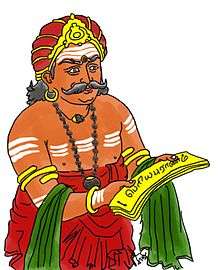Sekkizhar
| The twelve volumes of Tamil Śaiva hymns of the sixty-three Nayanars | ||
| Parts | Name | Author |
| 1,2,3 | Tirukadaikkappu | Sambandar |
| 4,5,6 | Tevaram | Tirunavukkarasar |
| 7 | Tirupaatu | Sundarar |
| 8 | Tiruvacakam & Tirukkovaiyar | Manikkavacakar |
| 9 | Tiruvisaippa & Tiruppallaandu | Various |
| 10 | Tirumandhiram | Tirumular |
| 11 | Various | |
| 12 | Periya Puranam | Sekkizhar |
| Paadal Petra Sthalam | ||
| Paadal Petra Sthalam | ||
| Raja Raja Chola I | ||
| Nambiyandar Nambi | ||

Sekkizhar (Tamil: சேக்கிழார்) was a poet and scholar of Tamil Shaiva Siddhanta,[1][2] a Saiva saint contemporary with the reign of Kulothunga Chola II.[3] He compiled and wrote the Periya Puranam (Great Purana), 4253 verses long,recounting the life stories of the sixty-three Shaiva Nayanars, the poets of Shiva who composed the liturgical poems of the Tirumurai. Sekkizhar's work itself became part of the sacred canon.[1]
Life
Sekkizhar was born in Kundrathur village in Thondaimandalam. Sekkizhaar was a scholar in both vedas as well as agamas as well as tirumurais. His original name was Ramadevan. He had been functioning as an inmate in a Vaishnavite shrine near Kanchi and at the instance of Lord ambujaksha(Lord vishnu) started working on tirumurais and nayanmars. when he was in chidambaram about to start on periyapuranam, Lord Siva famously instructed him with how to start.[1]
He moved to Chidambaram in order to compose Periyapuranam.[1][4] Among all the hagiographic Puranas in Tamil, the Periyapuranam (or Tiruttondar Puranam) stands first.[5]
Kulothunga Chola II, then a young king, was a devotee of Lord Siva Natraja at Chidambaram and continued the reconstruction of the center of Tamil Saivism that was begun by his ancestors.
The king thereupon invited Sekkizhar to expound the lives of the Saiva saints in a great poem. As a saiva saint, Sekkizhar knew about the lives of the saints and after he collected the data he wrote the poem in the Thousand Pillared Hall of the Chidambaram temple.[6] Sekkizhar would himself sing the Periyapuranam and arouse the latent Chola Saiva zeal and successfully bring the king back in line.[7]
Folklore has is that, when Sekkizhar sat pondering at Chidambaram temple as to how to begin his work, Lord Siva had appeared again and said his first verse should be:
Ulakellam unarnthu otharkku ariyavan
Nilavulaviya neermali veniyan
Alakil jothiyan ambalatthu aaduvan
malar chilambadi vaazhthi vanakuvomHe who is known to those who forsake attachments
He who is of plaited locks of hair in which river flows and baby moon grazes
He who is verily sublime light and who dances in the golden hall of chidambaram
lets worship his rosy anklet girt feet
This work is considered the most important initiative of Kulothunga Chola II's reign.[6] Although it is only a literary embellishment of earlier hagiographies of the Saiva saints it came to be seen as the epitome of Chola literary style.[6] The Periyapuranam is considered a fifth Veda in the Tamil and it immediately took its place as the twelfth and the last book in the Saiva canon.[5]
Research Centre
The Sekkizhar Research Centre conducts research on his epic Periyapuranam and the period, art, culture, civilization, rituals, socioeconomic conditions, and religion/secularism of the times and place surrounding it.
Temple for Sekkizhar
1. Kundrathur Sekkizhar Temple is located near Chennai. Click here for photos
2. The Devakottai Nagara Sivan Kovil (also called the Sekkizhar Kovil) is located in the Chettinad region of Sivagangai district in Tamil Nadu. Saint Sekkizhar is the procession deity of the temple. Click here for more info.
See also
References
- 1 2 3 4 A Dictionary of Indian Literature By Sujit Mukherjee
- ↑ http://www.hinduonnet.com/2002/06/04/stories/2002060400590800.htm
- ↑ Criminal Gods and Demon Devotees By Alf Hiltebeitel
- ↑ Encyclopaedia of Indian Literature By various
- 1 2 Medieval Indian Literature By K. Ayyappapanicker, Sahitya Akademi
- 1 2 3 The Home of Dancing Śivan̲ By Paul Younger
- ↑ The origin of Saivism and its history in the Tamil land By K. R. Subramanian, K. R. Subramanian (M.A.)